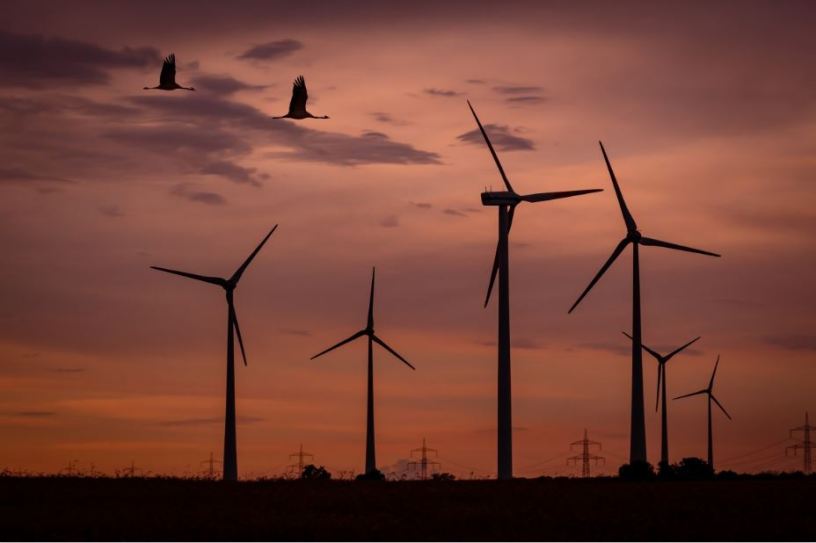https://jappliedecologyblog.wordpress.com/2018/03/29/wind-farms-affect-small-birds-too/
Wind farms affect small birds too

Julia Gómez-Catasús explains the need for a 4.5km threshold between wind farms and small-sized birds, based on the recently published article, Wind farms affect the occurrence, abundance and population trends of small passerine birds: The case of the Dupont’s lark.
Wind energy has experienced significant developments in recent decades, with China, United States, Germany, India and Spain being the main wind energy producers in the world. In a context of climate change, the benefits of this source of energy are undeniable due to a low rate of greenhouse gas emissions throughout its life cycle. However, wind turbines remain controversial, as their implementation has diverse environmental effects that should not be ignored. The surface occupied by wind facilities, the access roads to wind turbines, as well as substations and power lines can involve changes in land use and thus have important impacts on ecosystems.

The effect of these structures on birds have received considerable attention. Direct mortality through collision with wind turbines is the most well-known result, since pictures of dead vultures are widely seen and ever-shocking to us. But what is happening with small-sized birds? Due to their low detectability and high rate of carcass disappearance, fatality records of small-sized species are scarce and studies based on collision fatality records might be underestimating the impacts of wind farms on these species. So, how can we assess the effect of wind turbines on small-sized birds? To address this problem, fatality collision records have to be set aside and other approaches, such as species occurrence or abundance variation in relation to wind farm presence, have to be employed. Under these scenarios, it seems reasonable that if wind farms have an effect on bird species, it should be reflected through a lesser abundance or probability of occurrence in populations in closer proximity to wind farms.
In our recently-published study, we evaluated the effect of wind farms on a threatened small-sized species, the Dupont’s lark Chersophilus duponti, one of the scarcest passerine birds in Europe. Its distribution is restricted to the Iberian Peninsula and North Africa, and is classified as ‘Near Threatened’ in the IUCN Red List and as ‘Vulnerable’ in the European Red List of Birds. Wind farms have been broadly described as one of its major threats, though their impact has never been quantified. To carry out our assessment, we surveyed 14 Dupont’s lark populations in central Spain over a nineyear period (2008 – 2016); five populations in the presence of wind farms and nine in their absence. We then assessed how wind farms affected population trends during the whole period, and effects on Dupont’s lark occurrence and abundance in 2016; controlling by local connectivity and habitat availability estimates.
population trends were about 4 times more regressive in the presence of wind farms, highlighting the deleterious impact of wind farms on Dupont’s lark populations
The first thing we found was the worrying population trends undergone by this threatened species in the 14 populations under study (9% average annual decline), suggesting the existence of concomitant factors that explain overall declining population trends. Furthermore, we found that population trends were much more regressive in the presence than in the absence of wind farms. In the presence of wind farms, the Dupont’s lark underwent a 21.0% average annual decline whereas in their absence the species suffered a 5.8% average annual decline. That means that population trends were about 4 times more regressive in the presence of wind farms, highlighting the deleterious impact of wind farms on Dupont’s lark populations.
Our last finding was that Dupont’s lark occurrence and abundance in 2016 was significantly lower in populations closer to wind farms and more isolated. Moreover, we were able to identify a 4.5 km threshold distance to wind farms beyond which Dupont’s lark populations should be unaffected since the probability of occurrence of the species reaches its maximum.
The effect of wind farms on small-sized birds and their role as an accelerator of declining population trends in endangered species should not be overlooked. Moreover, the 4.5 km threshold distance should be taken into account in the design of future wind energy projects within the distribution areas of endangered passerine birds. This threshold could be a possible solution to alleviate the conflict between wind farm energy and Dupont’s lark, as well as conservation of other birds. However, future research should focus on disentangling the mechanisms underlying the detected turbine impacts in order to correctly design wind energy projects.
Read the full article, Wind farms affect the occurrence, abundance and population trends of small passerine birds: The case of the Dupont’s lark in Journal of Applied Ecology.
沒有留言:
張貼留言